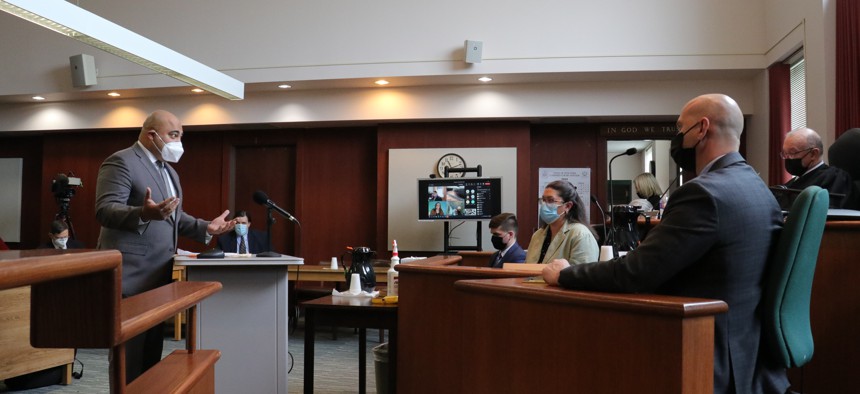New York State
Special master hears arguments in redistricting case
Lawyers for the GOP-backed plaintiffs in the case, along with attorneys for Democratic state leaders, attacked each other’s proposed maps in the Friday hearing.

Redistricting hearing on May 6. Vaughn Golden/WSKG
The special master appointed to redraw state Senate and congressional district maps heard arguments from members of the public and attorneys for both Republicans and Democrats on Friday in Steuben County Supreme Court, marking Jonathan Cervas’ first public appearance since he was appointed by a judge to handle the drawings.
Cervas did not speak publicly and the court did not make any determinations during the two-and-a-half hour hearing in Bath, presided over by Judge Patrick McAllister. At least one lawmaker, Democratic Rep. Ritchie Torres, along with 20-some members of the public, including advocates and representatives of community groups, were given three minutes to make their cases to Cervas. Attorneys for the Republicans who filed the initial lawsuit that upended the primary election process, along with lawyers for Democratic leaders who were behind the original maps that were deemed unconstitutional, were each allowed 15 minutes to speak.
The hearing comes after the State Court of Appeals tossed the congressional and state Senate maps, declaring they were drawn and approved in February by the Democrat-controlled Legislature in violation of the constitution, after the Independent Redistricting Commission failed to come to an agreement on the new lines. The court ruled the congressional map was gerrymandered by the Legislature, and put the process for redrafting both of the maps back into the hands of the Supreme Court. Cervas, who holds a doctorate in political science and has extensive experience in redistricting processes across the country, has until May 20 to redraft the maps. Friday’s hearing was one of the first steps in that process.
“Now this is not a time to cross-examine Dr. Cervas about his methodology in drawing maps. This is more like the 12 public hearings that were held around the state by the Independent Redistricting Commission,” McAllister explained to the speakers. “This is your time to express to Dr. Cervas any specific concerns you may have or anything you think needs to be drawn to his attention in drafting maps . . . it may be the whole map, it may be a district or districts or parts of districts . . . it may involve communities of interest, location of minority communities, geographic regions, those are just some examples.”
Alex Goldenberg, a lawyer for state Senate Democrats, argued that the Legislature’s state Senate map was “subjected to extensive testing . . . a trial . . . a lengthy petition . . . expert testimony” and cleaned up “malapportionment” in the previously enacted 2012 state Senate maps. He argued that the Democrats’ plan takes into account population growth in Brooklyn and Queens, in part, by creating a new “plurality Hispanic District 17” on the Brooklyn-Queens border.
Craig Bucki, arguing on behalf of Assembly Democrats, said that the new congressional map submitted by Democrats in recent days is largely the same as the now-voided map “because these are districts about which there was never any complaint over the course of the trial,” including districts in New York City, Buffalo, Rochester and Albany. Democrats did, however, make several changes in the newly submitted maps, including keeping the town of Smithtown in one congressional district. The map approved in February split the town into two districts, he said. The proposed congressional district 16 keeps African American communities in the Bronx and Mount Vernon together “as they have been for decades,” Bucki said, while district 10 keeps Jewish communities on the Upper West Side and Brooklyn together.
Districts in Hudson Valley were also adjusted in the newly proposed maps, Bucki said, to address “a number of complaints about the originally enacted map.”
Sean Dutton, a lawyer representing the GOP-backed plaintiffs in the case, accused Democrats of “packing and cracking Republicans across districts throughout the state in order to create Democratic advantage” in Congress. He argued that the new congressional map submitted to the court on behalf of the GOP-backed plaintiffs in the case “falls within neutral computer-drawn simulations. On the gerrymandering index, petitioners congressional map bears extremely well,” he said.
Dutton specifically addressed Republicans’ proposed congressional districts on Long Island, which he said “maintain the vast majority of the core of these districts” without splitting a significant number of municipal and county lines. The plaintiffs’ Long Island map, Dutton argued, also creates an Orthodox Jewish interest district in the 4th Congressional District.
Dutton called the 11th Congressional District “the biggest point of contention.” The district is represented by Rep. Nicole Malliotakis and covers Staten Island along with parts of southern Brooklyn, but was redrawn by Democrats to include parts of liberal Park Slope and Sunset Park. The newly proposed Republican version of the map “maintains 90% of the core” of the existing district.

NEXT STORY: What you need to know about rent hikes in New York City